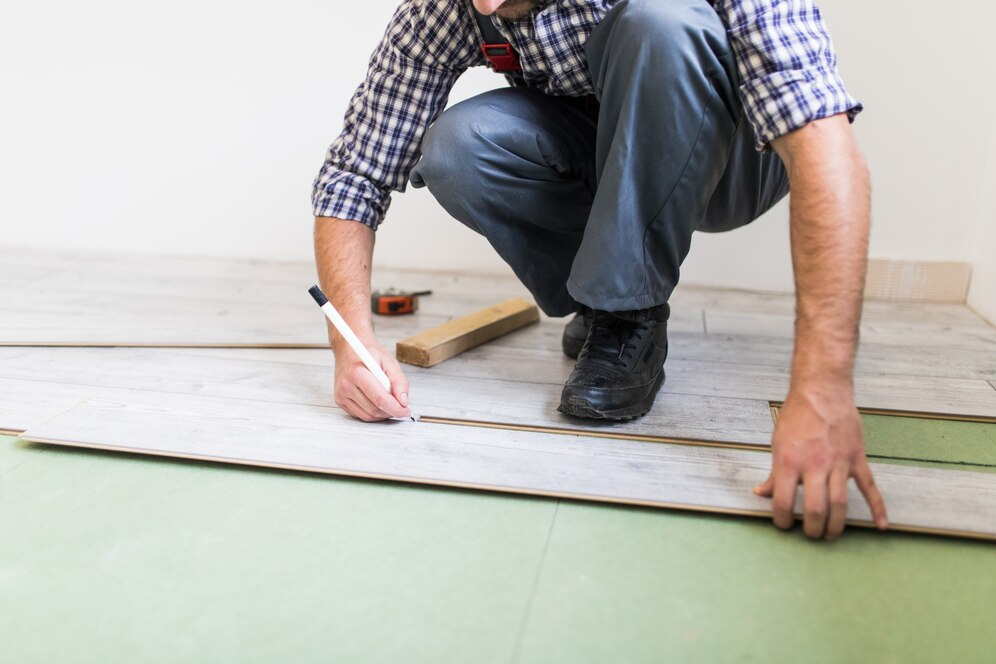

Vinyl flooring is a versatile and practical option that can fit well in almost any room of your home. But before we get into the installation, let’s look at the different types of vinyl flooring available.
There are three main types: sheet vinyl, vinyl tiles, and luxury vinyl planks.
Sheet vinyl comes in large rolls and is often used in spaces where a seamless look is desired. Vinyl tiles are smaller and can be arranged in various patterns, giving you more design flexibility. Luxury vinyl planks mimic the appearance of hardwood floors, offering the beauty of wood with the added benefits of vinyl, such as water resistance and ease of maintenance.
Choosing vinyl flooring offers several advantages. It is known for being durable, which means it can withstand heavy foot traffic and resist scratches and stains. Additionally, vinyl flooring is water-resistant, making it an excellent choice for kitchens, bathrooms, and basements.
It is affordable and has a wide range of styles and colors which makes it an attractive option for homeowners looking to enhance their home’s interior without breaking the bank.
One of the most critical parts of your flooring project is finding a reliable installer. A quick Google search for “vinyl flooring installation near me” will bring up several options, but how do you choose the right one?
Start by researching local installers. Online reviews, local directories, and word-of-mouth recommendations are great ways to gather information. Reading customer reviews can give you insights into the quality of work and customer service you can expect from different installers. Look for companies with consistently positive reviews and a good reputation in your area.
When you contact potential installers, don’t hesitate to ask questions.
Key questions include asking about their experience with vinyl flooring installation, whether they offer warranties on their work, and what their typical timeline is for completing a project. This conversation will help you gauge their expertise and whether they are a good fit for your needs.
It is also important to verify the credentials of the installer. Make sure they are licensed, insured, and bonded. This protects you in case of any accidents or issues during the installation process. Some installers may also have industry certifications, which can indicate a higher level of expertise and commitment to quality work.
Once you’ve chosen your installer and prepared your space, it’s time for the installation. Knowing what to expect on installation day can help you feel more confident and ensure everything goes smoothly.
Before the actual installation begins, there are a few preparations that both you and the installer will need to take care of. The installer will start by removing any old flooring and thoroughly cleaning the subfloor. They’ll also level the subfloor if necessary to create a smooth, even surface for the new vinyl flooring. As the homeowner, you may need to move furniture and clear the area to allow the installers easy access.
On installation day, the process typically begins with laying out the vinyl flooring to plan the placement of each plank or tile. For glue-down vinyl, the installer will apply adhesive to the subfloor before carefully placing each piece. For click-lock or floating floors, the planks are snapped together without adhesive. The installer will also make precise cuts to fit the vinyl around edges, corners, and obstacles like cabinets and doorways.
Once the flooring is laid, the installer will likely recommend waiting a certain period before walking on the floor or moving furniture back into the room. This allows the adhesive to set properly or the floating floor to settle. It is also a good idea to inspect the finished work closely to ensure everything looks perfect and meets your expectations.
After your vinyl flooring is installed, proper maintenance is key to keeping it looking great for years to come. Fortunately, vinyl flooring is relatively low-maintenance.
Regular sweeping or vacuuming will remove dirt and debris that could scratch the surface. A damp mop with a mild cleaner is usually all that is needed for a deeper clean. Be sure to avoid harsh chemicals or abrasive tools, which can damage the vinyl.
To protect your new floors, consider placing mats at entryways to catch dirt and moisture. Using felt pads under furniture legs can prevent scratches, and it is a good idea to lift heavy items rather than dragging them across the floor. If you encounter scuffs, scratches, or stains, address them promptly using recommended methods or consult your installer for advice.
Choosing the right flooring installation contractor can make all the difference in the quality and longevity of your new floors.
At My Dad’s Flooring, we offer top-notch flooring installation services tailored to meet your needs.
With years of experience and a commitment to customer satisfaction, we ensure your flooring project is completed to the highest standards.
Contact us today to get started on your flooring project and see why we are the best choice for flooring installation contractors near you.